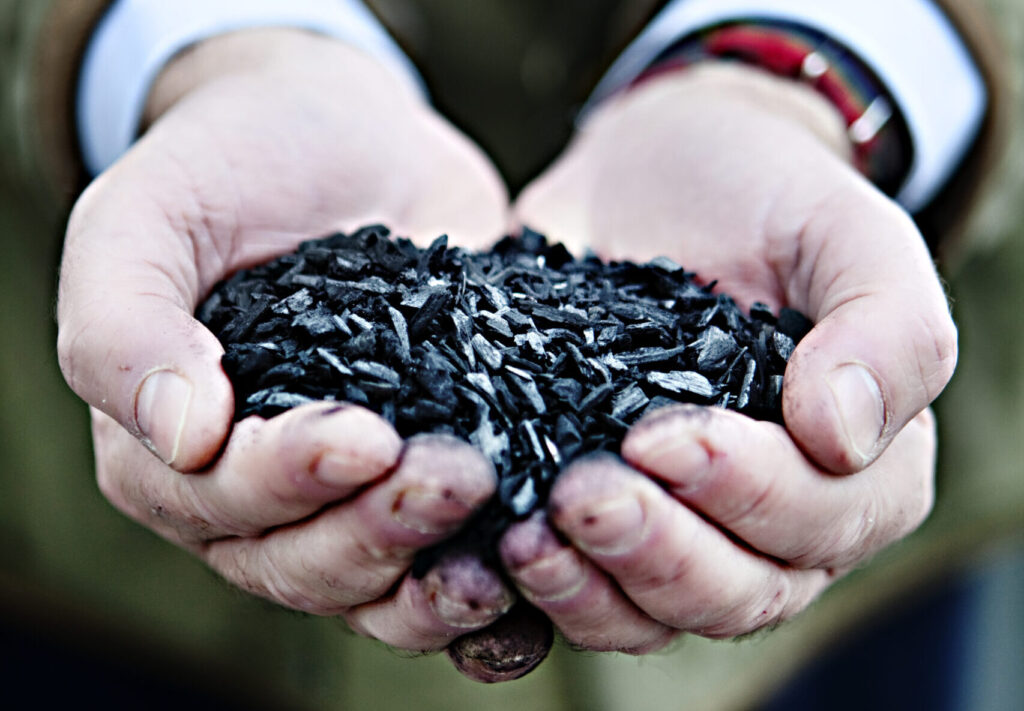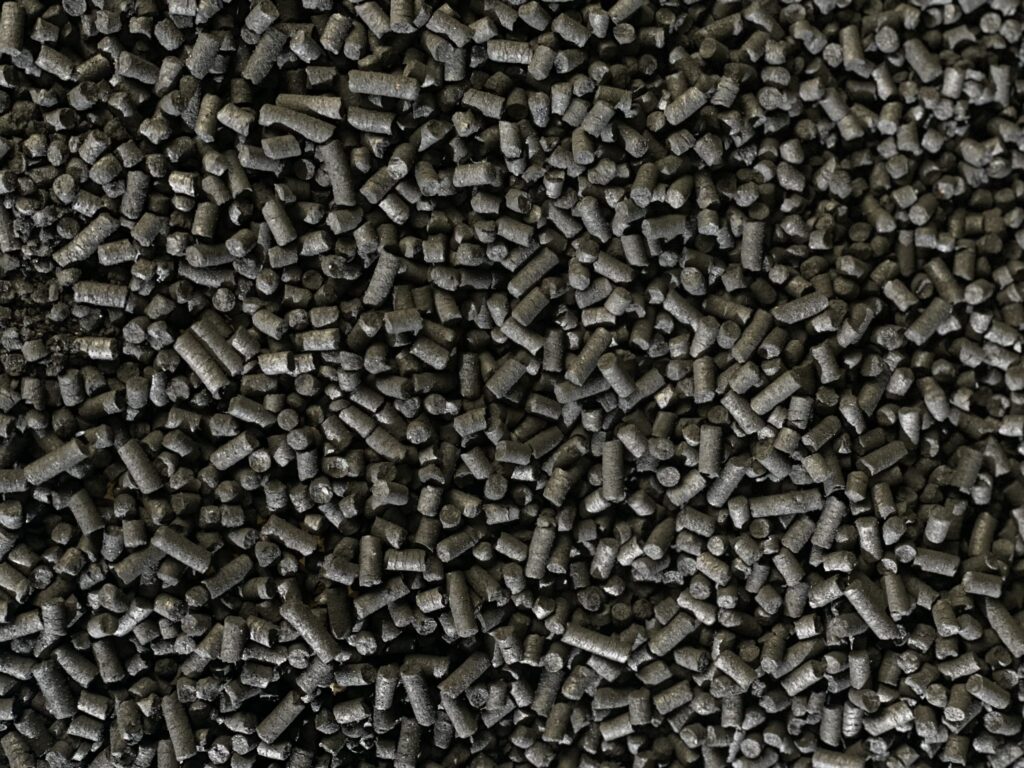The CIP Foundation leads the way to efficient carbon storage with biochar

Article
Biochar can underpin the green transition of Danish agriculture by storing carbon effectively and for a long time, providing a fertilizer product, and producing green energy during the process.
In socio-economic terms, the displacement costs of removing one tonne of CO2 from the atmosphere with biochar is very competitive compared with other climate measures.
In January 2024, the CIP Foundation launched a number of reports on the use of biochar as a climate measure. The main report How to establish a market for CCS with biochar in Denmark shows how biochar can support the agricultural sector in the comprehensive and investment-intensive green transition, and at the same time generate energy for the rest of society as well as other benefits.

Biochar from agricultural residues
Biochar is made of biomass residues with no other significant economic utility value. Typically, residues at the bottom of a cascade use of biomass. This could include biogas fibres, livestock manure, and straw residues that today are mulched on farmland, as well as other grass and plant residues. Or it could be residues such as sewage sludge and garden/park waste. In other words, side streams that can be reused, generate revenues and return important nutrients in cycle of uses, while potential substances of concern can be removed from the biomass.
Biochar is made by heating biomass residues in a pyrolytic oven, and this forms green energy in the form of pyrolysis gas (for heating and electricity), surplus heat (e.g. for district heating), and bio oil, which can be used in green fuels in sectors that would otherwise have difficulty transitioning. The solid residue is biochar, which can be used as fertilizer and to improve soil quality. It also has properties relevant for building materials for example. Furthermore, the biochar contains the carbon from the biomass in a solid and stable the form; i.e. carbon storage.
For more information about the process, watch our video here.
Biochar as a climate measure
It is relatively new in both Denmark and abroad to consider biochar as an effective climate measure. A negative emissions technology to capture and store CO2.
1 tonne biochar ~ 2 tonnes stored CO2e
The process also has other climate benefits: for example, treating biomass residues instead of spreading them directly on fields avoids emissions of potent greenhouse gases from the biomass. And the green energy from the process replaces fossil alternatives, thus displacing this type of emissions.
80 pct. of the carbon in biochar stays stored after 100 years and…
75 pct. stays stored after 1,000 years
This was demonstrated in a knowledge synthesis from Aarhus University in 2022. A number of other research papers have shown that the carbon storage is very long-term and stable.
It has been verified and documented that biochar stores carbon like other CCS technologies. This is new. In climate terms, biochar can help to “clean up” both after historical emissions, and after emissions which would otherwise be difficult to remove completely, for example emissions from soil and from livestock.
New climate measure based on well established technology
The actual use of biochar is nothing new. People in the Amazon region used biochar to enrich the soil more than 2,500 years ago. The soil in the rain forest is often sandy and infertile below the first thin, but fertile soil layer. Adding biochar made it possible to transform the soil and make it richer and more fertile to cultivate food.
In Europe and a number of other countries, biochar is today used to improve the soil on farms and as a fertilizer for gardens and parks. And in some places it is also mixed in concrete, asphalt and various other materials.
Enough biomass to meet political targets
NIRAS has examined the extent of relevant biomass residues in Denmark that can be used for biochar. Using five of the major sources (ungathered straw residues, digestate, deep litter, garden/park waste and sewage sludge), there are enough biomass residues to achieve the target in the Agriculture Agreement to store two million tonnes CO2e annually from 20301. And there is great potential for more biomass residuals from Danish agriculture, with up to 10 million tonnes of bioresources in 2030, see Nationale Bioøkonomiske Panel.
Biochar also provides good opportunities to reuse important nutrients such as phosphorus and potassium from the biomass and redistribute them between agricultural land. Phosphorus is crucial for plant growth, but it is also a scarce resource, which is extracted from mines, imported and spread on fields as artificial fertilizer. Biochar also has a liming effect on the soil.
Biochar is not just biochar…
The biggest benefits come when the biochar is used on agricultural land as fertilizer and to improve the water retention properties of the soil to help limit nitrogen run-off from the soil to wetlands.
However, it is not that easy to generalise the effects of using biochar. Biochar is not just biochar. The effects depend on a number of factors: the biomass biochar is made of, the treatment process it has been through, and the type of soil it is used on.
There is already a great deal of research about the effects of using biochar, including Danish studies. However, there is a need to ensure that the results are collated systematically and categorised, so that it is easier to see where best the biochar can be used, and what type.

Climate credits pay for the carbon storage
The CIP Foundation has examined the business case behind various types of biochar for the entire value chain, and has concluded that it is financially viable, provided there is a contribution to payment for the carbon storage. It’s not free. Someone has to pay for the positive climate effects of biochar, if farmers and pyrolysis plants are to get anything out of it.
Today, payment can come from the market for purchases and sales of climate certificates, from higher prices of products in the value chain that benefit from the lower climate footprint, or from CCS aid.
A climate certificate is proof that one tonne of CO2 has been removed from the atmosphere. When a certificate is traded, it is called a climate credit.
There are good prospects for co-financing carbon storage in biochar through the growing global market for climate credits, because the technology supplies reliable and long-term storage which can be localised. Furthermore, biochar has a number of spin-off benefits, which also affect willingness to pay.
Purchasers of a climate certificate can use it in their climate accounts. Prices for climate certificates are currently around EUR 130 per tonne CO2e, however, the market for climate credits (carbon removals) is still in the start-up phase, and there is great uncertainty regarding future prices. For example, see the analysis of the market for climate credits prepared by SEGES Innovation for the CIP Foundation here (only available in Danish).
A European standard for certification of carbon removal and a common register are on the way from the EU, and these could strengthen the market for purchases and sales of climate certificates, with more transparency and credibility.
Biochar as a climate measure makes good socio-economic sense
Socio-economicslly, the cost of storing one tonne of CO2 with biochar is competitive compared with other CCS technologies such as direct air capture (DACCS) and burning of biomass in heating plants (BECCS), where the carbon is subsequently captured at the chimney and stored in the subsoil. Among other things, this is because of several positive side-effects, e.g. the nutrients are recirculated instead of being burnt at a CHP plant, and lower production prices. See the EA Energy Analyses for the CIP Foundation here (only available in Danish).
Therefore giving biochar access to apply for CCS aid on equal terms with these technologies should be considered. This would also support development of an industry for biochar by reducing some of the risk.
Biochar has climate potentials to contribute to Denmark’s 2030 target, including the specific goals for agriculture. But it will take time to develop a new production infrastructure and achieve the climate impacts. And the more uncertainty, the more expensive it is to make a move.
Need for a clear framework
Technologically, Denmark is well on the way, with biochar production at 12 different locations in Denmark. With a good geographical spread and with variation in the size of the plants and in how and from what source the biochar is produced. And more plants are on the way.
At present the most important challenges associated with commercialisation of biochar are associated with the absence of direct regulation of biochar in Danish legislation. The longer this takes, the less biochar will be able to contribute to climate targets in the short term. However, the potential is great: and greater still after 2030, with later targets such as climate neutrality in 2045 and net negative status in 2050.
Read more and find the answers to your questions about biochar in the CIP Foundation’s main report and additional information here.

